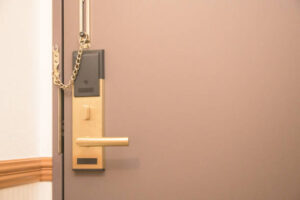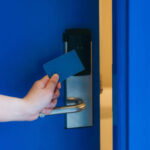The Unsung Heroes of High-Security Systems
When you think about high security door locks, deadbolts probably come to mind. They’re the unsung heroes in keeping your home or business safe. But did you know there’s more than one type? Yep, we’ve got single cylinder and double cylinder deadbolts on the menu. Let’s dive into what makes each tick.
Picture this: You’re at a hardware store, staring at rows upon rows of locks. It’s like being a kid in a candy store but with way more responsibility. Single cylinder deadbolts catch your eye first because they’re pretty straightforward—keyed on the outside and thumb-turn on the inside.
Now, why would anyone choose these bad boys? For starters, convenience is their middle name. Imagine coming home with an armful of groceries; all you need is that trusty key to get inside quickly without fumbling around too much.
But wait! There’s always another side to every coin. Single cylinders have a chink in their armor—they can be vulnerable if there’s glass nearby or if someone breaks through an adjacent window and simply turns that thumb-turn from the inside.
Enter double cylinder deadbolts—the beefier cousin who takes no nonsense from intruders. These require keys both outside AND inside, making it trickier for anyone trying to pull off some sneaky business by breaking windows or doors close by.
Sounds perfect right? Well hold your horses! Double cylinders aren’t without their quirks either—think fire hazards during emergencies where finding keys could mean precious lost seconds escaping danger zones within homes/offices etcetera!
Let me tell ya about my buddy Jim—a die-hard fan of double cylinders until he had kids running around his house 24/7… One day little Timmy locked himself IN while playing hide-and-seek—and guess what?! No one knew where those darn spare keys were hidden!! Talk about heart-stopping moments!!

So, Jim had to rethink his strategy. He realized that while double cylinders offer a higher level of security, they also come with their own set of headaches. It’s like having a super-secure fortress but losing the key every now and then.
Let’s not forget about installation either. Both types need proper fitting to be effective—no cutting corners here! A poorly installed deadbolt is like putting up a cardboard cutout for protection—it looks good but won’t do much when push comes to shove.
And what about aesthetics? Some folks swear by the sleek look of single cylinders, especially in modern homes where style points matter just as much as safety. On the flip side, traditionalists might lean towards double cylinders for that extra peace of mind—even if it means sacrificing some convenience.
Here’s another nugget: maintenance matters too! Regularly check your locks for wear and tear because even Superman would struggle with rusty kryptonite… You get my drift?
In short (pun intended), choosing between single and double cylinder deadbolts boils down to weighing pros against cons based on individual needs/preferences/situations etcetera! There isn’t one-size-fits-all answer; rather finding balance tailored specifically around personal circumstances remains crucial decision-making factor overall!!
Remember folks—a lock is only as strong its weakest link so make sure yours doesn’t have any glaring vulnerabilities lurking beneath surface waiting pounce unsuspecting moments least expected!!!
The Unsung Heroes of High-Security Systems
Ever wondered why your front door feels like Fort Knox? It’s probably because of those high security door locks, specifically deadbolts. These unassuming pieces of metal are the backbone of any robust home security system. Let’s dive into what makes them tick and how to install them for maximum protection.
First off, let’s get something straight—deadbolts aren’t just another lock on the block. They’re designed to keep intruders out with a vengeance. Unlike spring bolt locks that can be jimmied open with a credit card, deadbolts need a key or thumb turn to move the bolt from its locked position.
Now, before you rush out and buy one, let’s talk about installation best practices. You wouldn’t want to slap it on haphazardly and call it a day.
Choosing Your Deadbolt
Not all deadbolts are created equal. There are single-cylinder and double-cylinder options available. Single-cylinders have a keyhole on one side and a thumb turn on the other—great for quick exits in case of emergencies but not as secure if there’s glass nearby that someone could break to reach in and unlock it from inside.
Double-cylinders require keys both inside and outside—super secure but potentially hazardous during an emergency when you might need to exit quickly.
Tools You’ll Need
Before getting started, gather these tools:
– Drill
– Screwdriver
– Hole saw kit (usually 2 1/8 inches)
– Chisel
– Tape measure
Having everything ready will save you time—and possibly some frustration!
Marking & Drilling Holes
Measure twice; drill once! Mark where you’ll place your new deadbolt about six inches above your existing doorknob for optimal security.
Use your hole saw kit to cut through the marked spot on your door carefully—you don’t want splinters flying everywhere! Then drill smaller holes through which screws will pass later.
For drilling into metal doors—a different beast altogether—you’ll need specialized bits made for cutting through steel or aluminum without warping them beyond recognition!
Installing The Bolt Mechanism
Slide-in part A meets slot B—it sounds simple enough until you’re halfway there wondering why nothing fits together anymore! Make sure everything aligns perfectly before screwing anything down permanently; otherwise redoing this step could become more common than you’d like!
Once you’ve got the holes drilled and everything aligned, it’s time to install the bolt mechanism. Slide the bolt into place through the edge of your door, ensuring that it fits snugly within its designated hole. Secure it with screws, but don’t over-tighten them—you want a firm hold without stripping anything.
Attaching The Strike Plate
Now for the strike plate—the part that attaches to your door frame. This is where many folks mess up! Mark where the deadbolt will hit when extended; this needs to be precise for smooth operation. Chisel out enough wood so that your strike plate sits flush against the frame.
Use long screws (at least 3 inches) to secure it in place—these should penetrate deep into your wall stud rather than just sitting in flimsy door trim. It adds an extra layer of security by making forced entry more difficult.
Testing Your Work
Moment of truth: test your new deadbolt! Lock and unlock several times from both sides to ensure everything moves smoothly without resistance or jamming. If something feels off, better tweak now than regret later!






